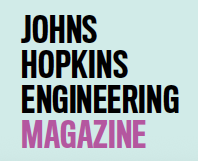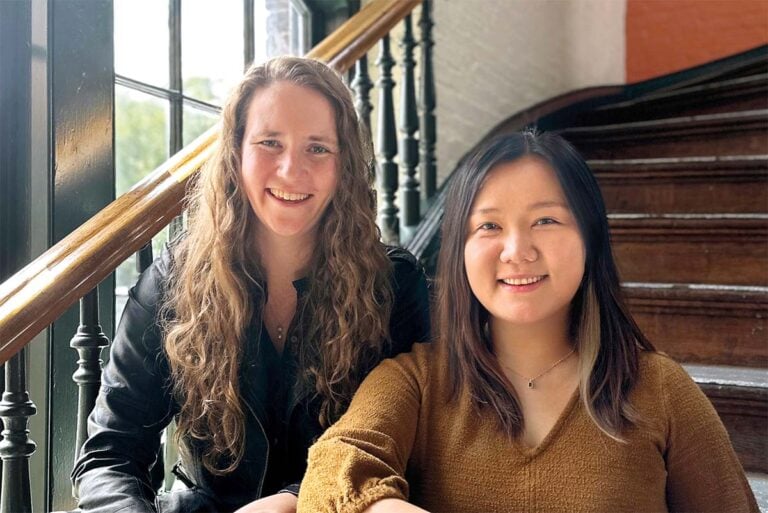Bailey Surtees, Engr ’17, and Clarisse Hu, Engr ’17, ’19 (MSE), met as biomedical engineering undergraduates and have been working together ever since, founding an award-winning company whose origins go back to their student days.
Kubanda Cryotherapy offers the first minimally invasive treatment for lumps, bumps, and tumors in pets. By adapting cryotherapy, which has been used in human medicine for more than 60 years, their team is bringing human-quality care to humankind’s best friends.
The duo’s novel CryoNeedle system uses focused, extreme cold to quickly and easily treat tumors, avoiding the need for invasive surgery. After eight years of postgrad research and development, including clinical trials at The Johns Hopkins Hospital, Kubanda is now offering its treatments to veterinary clinics everywhere—enabling legions of families to help their beloved pets skip the scalpel.
Surtees serves as Kubanda’s CEO and Hu as CTO. The pair attribute their success to complementary skill sets and an unlikely set of shared experiences. “There’s just an ease between the two of us,” says Hu. “We have all these weird connections. I was raised in Shenzhen, China, and Bailey grew up in Oklahoma. It turns out her great-grandmother was raised in China.”
“And we were both interested in bioengineering from a young age,” adds Surtees. “When I was 12, I had reconstructive work done because I’m deaf in my left ear, which sparked a fascination with the intersection of engineering and biology. Meanwhile, Clarisse grew up with a mom who’s an ENT surgeon, which spurred her to spend many years doing research on ear implants.”
The technology behind Kubanda was originally developed for people, not pets. The idea was born in 2015 as a Department of Biomedical Engineering Design Team project, where Johns Hopkins Medicine clinicians present large-scale biomedical engineering problems for students to take on. In this case, the nine-member team, working with faculty advisor Nicholas Durr, co-director of the undergraduate design team program, and clinician and then-Director of Breast Imaging Susan Harvey. The team’s initial idea was to work toward better diagnoses, but after visiting South Africa to study the issues firsthand, they came to realize a bigger problem was access to treatment after diagnosis. Women living in rural areas often can’t make the long journey to a city to receive surgery, chemotherapy, and radiation. The question became: how to increase their survival rate?
The answer lay in creating a low-cost device that could treat patients locally with a minimally invasive procedure. By freezing the cancer tissue at extremely low temperatures, cryoablation offered a way to do that. But such devices are often prohibitively expensive. The team’s innovation was to take a fresh look at the coolant. The typical choice, argon gas, is expensive and difficult to source, while carbon dioxide can be found anywhere that sells Coca-Cola.
The next hurdle was achieving the same cooling power using this less expensive cryogen. The team earned a patent for their process, published papers on its use, and formed a company to continue developing the technology. In tribute to its South African origins, its name comes from the Zulu word for cold—Kubanda.
The pivot from people to pets came when Surtees and Hu saw that the veterinary market faced the same paradox they observed in South Africa: While diagnosis is easier than ever before, treatment remains out of reach for the majority of families. They realized that applying their technology in the veterinary space could serve as a beachhead be- fore expanding into large animals and human medicine—allowing the pair to quickly commercialize the technology while de-risking future growth.
“In fact, our commercial success has accelerated the timeline to use in human medicine,” says Surtees. “We love that we’re able to use our expertise in cryotherapy to expand access to care while developing a sustainable business model to help pets and people everywhere.”
The world has taken notice, including Forbes magazine, which this year bestowed its 30 Under 30 in Science Award on Hu. “We’d been nominated as a pair for many years,” says Hu. “This year we won, but Bailey missed the cutoff age by a month. I’m representing us both because she is integral to all of it.”
Looking ahead, their focus is on equity. Surtees and Hu are uncomfortable with the discrepancy between the number of people in need and the advanced technologies only available to high-income patients.
“We have all this innovation, but it’s still not reaching the point where it needs to be,” says Hu. “Seeing that gap is what convinced the both of us to do some- thing about it…to be the change we want to see.”
“Hopkins taught us that,” agrees Surtees. “The ability to think more broadly, expand into different areas of research, and secure the resources that you need to bring your big idea to life. Everything thrives when you have interdisciplinary collaboration and relationships with people who have your back.
photograph by Naomi Gordon


